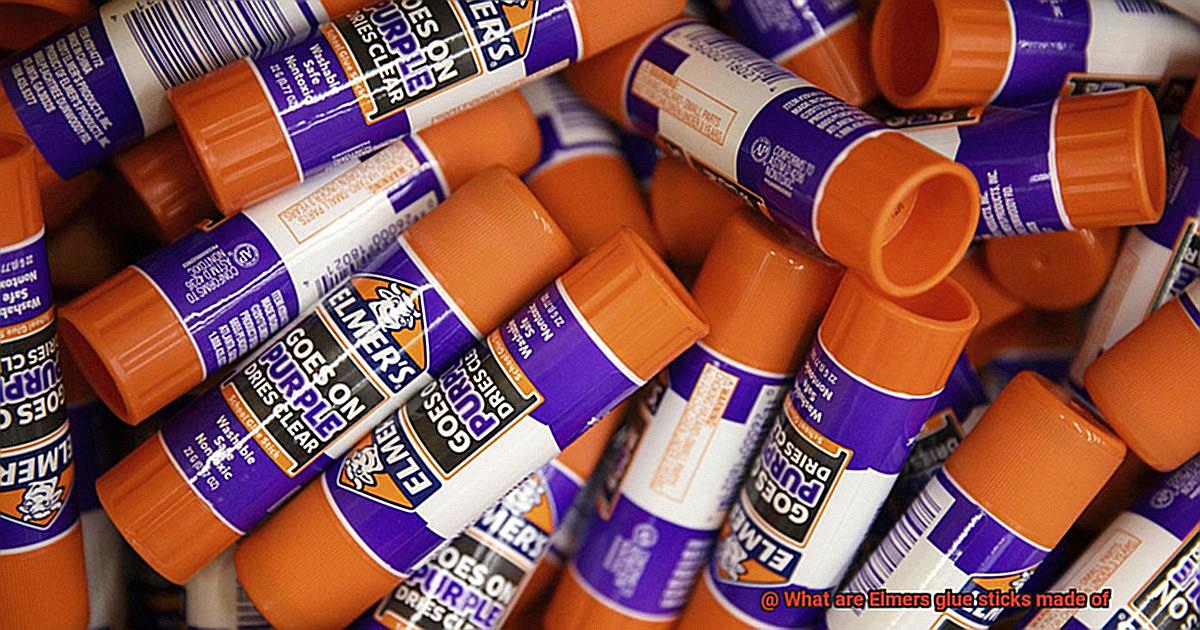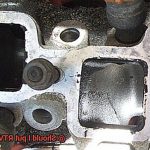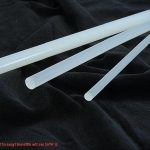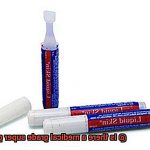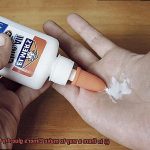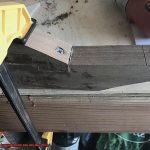Curious about what Elmer’s glue sticks are actually made of?
Well, prepare to be amazed. These trusty sidekicks of arts and crafts enthusiasts are packed with non-toxic goodness.
The secret sauce? A synthetic polymer called polyvinyl acetate (PVA) that gives the glue its super stickiness.
But that’s not all. Elmer’s glue sticks also contain water, thickeners to make it nice and gooey, preservatives to keep nasty mold at bay, and a smidge of wax for smooth application.
So, let’s dive into the chemical wizardry behind these little wonders – it’s going to be one heck of a ride.
What are Elmer’s Glue Sticks Made Of?
Contents
- 1 What are Elmer’s Glue Sticks Made Of?
- 2 The Main Ingredient: Polyvinyl Acetate (PVA)
- 3 Other Additives in Elmer’s Glue Sticks
- 4 Colorants in Some Variants of Elmer’s Glue Sticks
- 5 Advantages of Using Elmer’s Glue Sticks
- 6 Disadvantages of Using Elmer’s Glue Sticks
- 7 How to Use Elmer’s Glue Sticks Properly?
- 8 Alternatives to Elmer’s Glue Sticks
- 9 Conclusion
Elmer’s glue sticks have become a staple in classrooms, offices, and craft rooms. But have you ever wondered what makes these glue sticks so special? In this article, we will delve into the composition of Elmer’s glue sticks to uncover the magic behind their effectiveness.
The Main Ingredient: Polyvinyl Acetate (PVA):
At the heart of every Elmer’s glue stick lies a synthetic polymer called polyvinyl acetate (PVA). This remarkable substance is responsible for the glue’s adhesive properties. PVA is a thermoplastic that can be melted and solidified repeatedly without significant chemical changes. This characteristic allows the glue stick to be easily applied and solidify upon drying.
The Supporting Cast: Additives for Enhanced Performance:
To optimize functionality and performance, Elmer’s glue sticks contain additional additives. These include water, solvents (or solvent-free alternatives), preservatives, and colorants.
Water:
Water is added to adjust the viscosity of the glue stick, making it easier to spread and ensuring better coverage. It also helps the glue bond with various surfaces, providing a strong adhesive hold.
Solvents (or Solvent-Free Alternatives):
In some formulations, solvents are used to dissolve certain materials and improve adhesion. However, many modern glue sticks are designed to be solvent-free for increased safety and environmental friendliness. These solvent-free alternatives provide effective adhesion without compromising health or the planet.
Preservatives:
Preservatives are included in the glue stick formulation to prevent the growth of mold and bacteria. This extends the product’s shelf life and ensures its effectiveness over time. With these preservatives, you can count on your Elmer’s glue stick to remain fresh and ready to use whenever you need it.
Colorants:
For added fun and creativity, colorants may be added to Elmer’s glue sticks. This allows them to dry clear or in various vibrant colors, enhancing the visual appeal of crafts and projects. Whether you’re creating a colorful masterpiece or need the glue to blend in seamlessly, Elmer’s glue sticks have got you covered.
The Main Ingredient: Polyvinyl Acetate (PVA)
Polyvinyl acetate (PVA) is the secret ingredient that gives Elmer’s glue sticks their incredible adhesive power. As a thermoplastic polymer, PVA is a man-made material derived from the monomer vinyl acetate. This chemical process transforms vinyl acetate into a strong and versatile PVA polymer that forms a powerful bond between surfaces when it dries.
The versatility of PVA is one of the reasons it is widely used in adhesives and glues. It has the remarkable ability to bond to an extensive range of materials, including paper, fabric, wood, and plastic. So whether you’re working on a school project or repairing a broken toy, PVA glue sticks have got you covered.
Not only is PVA highly effective, but it is also safe for use in schools and homes. It is non-toxic, alleviating any concerns about harmful chemicals when using Elmer’s glue sticks.
The convenience of PVA glue sticks lies in their solid stick form. With a simple application directly onto the surface you want to bond, the heat from friction causes the PVA to melt and spread onto the surface. As it cools and hardens, it creates a strong bond that will hold your project together. And thanks to their solid form, spills or leaks are not a concern when storing or transporting PVA glue sticks.
Available in various sizes, PVA glue sticks are perfect for crafts, school projects, and everyday household repairs. Whether you’re working on delicate paper crafts or heavy-duty woodworking, PVA glue sticks provide reliable adhesive properties.
Other Additives in Elmer’s Glue Sticks
Prepare to embark on a journey into the captivating realm of glue. Yes, you heard it correctly – glue can indeed be captivating. Today, we shall delve into the world of Elmer’s Glue Sticks and uncover the other additives that contribute to their enchantment. So gather your crafting supplies and let us immerse ourselves in this sticky topic.
First and foremost, let us acquaint ourselves with stearic acid. This wax-like substance serves as a glue whisperer, skillfully regulating the flow of the adhesive for a flawless and uniform application. Bid farewell to clumps and uneven distribution – stearic acid is here to save the day.
Now, let us turn our attention to the superheroes of the glue world – preservatives. Sodium benzoate and potassium sorbate, commonly utilized preservatives, swoop in to rescue your glue stick from untimely spoilage and desiccation. With their vigilant presence, your glue stick’s shelf life is extended, ensuring its reliability for future crafting endeavors.

But wait, there’s more. Some Elmer’s glue sticks contain a delicate hint of fragrance. Yes, you heard it right – not only will your crafts be visually stunning, but they will also exude a delightful aroma. However, it is essential to note that fragrances are added sparingly to prevent any irritation or allergic reactions.
Now, let us explore the realm of color. Elmer’s glue sticks may be infused with coloring agents that imbue them with a vivacious and vibrant hue. It is akin to infusing your projects with a splash of personality. Dyes and pigments work harmoniously to create these mesmerizing colors that elevate the joy of gluing.
Last but certainly not least, some Elmer’s glue sticks conceal secret additives with specific purposes. These hidden gems grant your creations enhanced durability or expedite drying time. They are akin to possessing a clandestine weapon in your arsenal of adhesives.
Colorants in Some Variants of Elmer’s Glue Sticks
Elmer’s glue sticks are a must-have for any arts and crafts enthusiast. They’re not just convenient and mess-free; they also come in a range of vibrant colors that can add a pop of excitement to any project. But have you ever wondered how these glue sticks get their eye-catching hues? Let’s dive deeper into the world of colorants used in some variants of Elmer’s glue sticks and how they impact the adhesive properties.
The colored variants of Elmer’s glue sticks owe their beautiful shades to the inclusion of synthetic dyes or pigments as colorants. Synthetic dyes are chemical compounds that are soluble in the glue, meaning they dissolve and mix with the adhesive to create a uniform color. On the other hand, pigments are finely ground solid particles that remain suspended in the glue, providing color through reflection or absorption of light.
The specific colorants used in Elmer’s glue sticks may vary depending on the desired hue and formulation of each variant. These colorants undergo rigorous testing to ensure they meet safety standards and regulations for use in consumer products. So whether you’re using white, clear, or colored Elmer’s glue sticks, rest assured that they are non-toxic and safe for children to use under normal conditions.
While colorants enhance the visual appeal of the glue sticks, they do not compromise their adhesive properties. Elmer’s glue sticks are primarily designed for paper-based projects, so the colorants used are safe for use on paper and other similar materials.
So go ahead and unleash your creativity with Elmer’s glue sticks in vivid colors. Whether you’re working on an art project, scrapbooking, or simply sticking things together, these vibrant glue sticks will add an extra touch of brilliance to your work. Remember to choose the variant that best suits your project and let your imagination soar.
Advantages of Using Elmer’s Glue Sticks
These handy adhesive tools offer a multitude of advantages that make them a must-have for any project, whether it’s in the classroom, office, or at home.
First and foremost, Elmer’s Glue Sticks provide a mess-free application. Say goodbye to drips and spills that can ruin your project or leave behind unsightly marks. With glue sticks, you can enjoy a clean and precise application every time. This makes them perfect for working with children or handling delicate materials where precision is key.
Not only are glue sticks mess-free, but they are also incredibly easy to use. The solid stick form allows for smooth and controlled application. You can apply the glue exactly where you want it without any hassle. Plus, the convenient twist-up mechanism ensures that the glue remains protected and can be easily dispensed whenever you need it.
Time is of the essence when it comes to completing projects, and that’s where Elmer’s Glue Sticks shine. Unlike liquid glues that require time to dry and set, glue sticks dry rapidly once applied. This means you can move on with your project without having to wait around for the glue to dry. It’s perfect for those time-sensitive tasks or when you simply want to get things done quickly.
One of the best things about Elmer’s Glue Sticks is their clean and neat appearance. The glue dries clear, leaving no visible residue or marks on the surface. This is particularly important when working on presentations, scrapbooking, or any other project where aesthetics matter. You can achieve a professional finish without worrying about any unsightly glue marks.
Versatility is another key advantage of Elmer’s Glue Sticks. They can be used on various materials such as paper, cardboard, fabric, photos, and more. They provide a strong bond that holds well on different surfaces, making them suitable for a wide range of applications. Whether you’re working on school projects, arts and crafts, or even light repairs, Elmer’s Glue Sticks have got you covered.
Safety is always a concern, especially when working with children. That’s why Elmer’s Glue Sticks are made with a non-toxic formulation. They comply with safety standards and do not contain harmful chemicals. You can have peace of mind knowing that these glue sticks are safe to use, even in educational settings.
Last but not least, Elmer’s Glue Sticks are designed to be long-lasting. The solid stick form prevents drying out or evaporation, ensuring that the glue stick remains effective and adhesive over time. Once applied, the bond created by Elmer’s Glue Sticks will stay strong and durable.
Disadvantages of Using Elmer’s Glue Sticks
Elmer’s Glue Sticks may seem like the go-to adhesive choice for many, but before you reach for that trusty stick, it’s important to consider the disadvantages. As an expert in the world of glue, let me shed some light on the downsides of using Elmer’s Glue Sticks.
First and foremost, one of the main drawbacks of glue sticks is their lack of strength compared to liquid glue. While they may be mess-free and easy to use, they simply don’t provide the same level of bonding power. This can be a real issue when working with heavier materials or when a strong adhesive is needed.
Another disadvantage is the tendency of glue sticks to dry out quickly. Unlike liquid glue, which can be stored for a longer period of time, glue sticks have a habit of drying up if not used frequently. This can result in wasted product and the need to constantly purchase new glue sticks.
Furthermore, glue sticks have limited application options. They work best on paper and lightweight materials, making them less versatile than liquid glue. If you’re dealing with different types of materials or surfaces, such as fabric or plastic, a glue stick may not be your best bet.
One thing that some users find frustrating is that glue sticks can leave behind visible residue on surfaces. This can be especially noticeable on darker or more delicate materials. Removing this residue can be difficult and may require additional cleaning methods.
In addition, the packaging of glue sticks can sometimes be problematic. The twisting mechanism used to push up the glue can malfunction or break, making it difficult to access the remaining adhesive. This can waste product and make it frustrating to use the glue stick until it’s completely finished.
And finally, while Elmer’s glue sticks are generally non-toxic and safe for children to use, they still pose a risk if ingested. Young children may mistake the glue stick for a snack or candy due to its appearance, so it’s important to keep them out of reach and supervise their use.
How to Use Elmer’s Glue Sticks Properly?
These magical adhesive tools are the perfect companions for all your crafting, school, and office projects. But before you dive in headfirst, let us equip you with the knowledge of how to use Elmer’s glue sticks properly. Get ready to stick it to perfection.
Prepare the Surface:
Before you unleash the adhesive power of an Elmer’s glue stick, ensure that the surface you’re working with is clean and free from any lurking dust bunnies or dirt particles. A pristine surface guarantees a strong and reliable bond between materials.
Twist it Right, Apply with Delight:
To access the glue, twist the bottom of the stick gently. Take care not to go overboard with the twisting; we don’t want any precious glue going to waste. With a steady hand, apply a thin and even layer of glue onto one of the surfaces you wish to bond.
The Perfect Bond:
Now it’s time for some bonding magic. Bring those surfaces together with confidence and press firmly and evenly. Remember, proper alignment is key. Ensure that the edges match up flawlessly before applying pressure.
Oops. Repositioning Made Easy:
Made a tiny mistake? No worries. Elmer’s glue sticks allow for temporary bonding. Simply separate the surfaces and reapply fresh glue where needed. Phew. Crisis averted.
Clean Up and Store:
After using the glue stick, twist it back down to retract the adhesive. This prevents any unwanted drying out and keeps your glue stick ready for your next crafting extravaganza.
Alternatives to Elmer’s Glue Sticks
Well, look no further. I have a list of fantastic alternatives that will blow your mind and elevate your crafts to new heights. Whether you’re a seasoned crafter or just starting out, these alternatives will give you the adhesive power you need, with some added benefits. So, let’s dive in and explore the world of glue.
- Liquid Glue: If precision and control are what you’re after, then liquid glue is the answer. Brands like Elmer’s Liquid School Glue offer the same adhesive properties as glue sticks but in a liquid form. With a brush or spreader, you can easily apply it, allowing for intricate designs and sticking to different surfaces with ease.
- Glue Dots: For lightweight crafts or temporary adhesion, glue dots are a game-changer. These small double-sided adhesive dots provide a strong bond and are super easy to use. Just peel them off and stick them on paper, fabric, or other materials – no mess, no fuss.
- Tape Runners: If you love paper crafts like scrapbooking or card-making, tape runners are a must-have. These nifty devices dispense a thin strip of adhesive onto your desired surface with precision and ease. Say goodbye to sticky fingers and hello to mess-free crafting.
- Hot Glue Guns: When you need a strong bond on various surfaces, hot glue guns are your best friend. They use melted glue sticks to create a powerful adhesive that can stick wood, fabric, plastic, and even metal together. Just be careful with those hot glue gun burns.
- Homemade Flour Paste: Looking for an eco-friendly alternative? Look no further than homemade flour paste. Mix equal parts flour and water until you achieve a thick consistency, then apply it with a brush or spreader. It works wonders on paper-based crafts and is completely natural.
- Double-Sided Tape: Mounting photos or artwork? Double-sided tape is your go-to. This tape has adhesive on both sides, making it perfect for creating a clean and seamless bond between different materials. No need to worry about damaging your precious memories.
- Also Read: Is Elmer’s Glue Eco-Friendly?
Conclusion
Elmer’s glue sticks are made of a unique formula that combines various ingredients to create a versatile adhesive.
These ingredients include water, synthetic polymers, and additives. The water acts as a solvent, allowing the glue to spread easily and bond effectively.
The synthetic polymers provide the adhesive properties, ensuring that the glue sticks firmly to surfaces. Additives are also incorporated into the formula to improve performance and durability.
These may include preservatives to prevent mold or mildew growth, thickeners to control viscosity, and colorants for aesthetic purposes.

